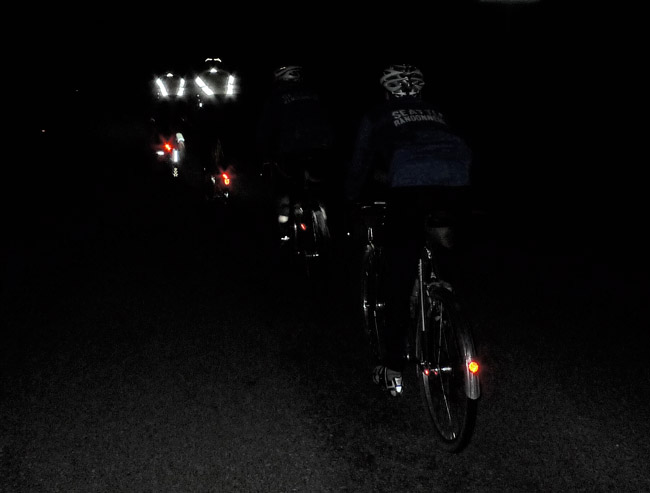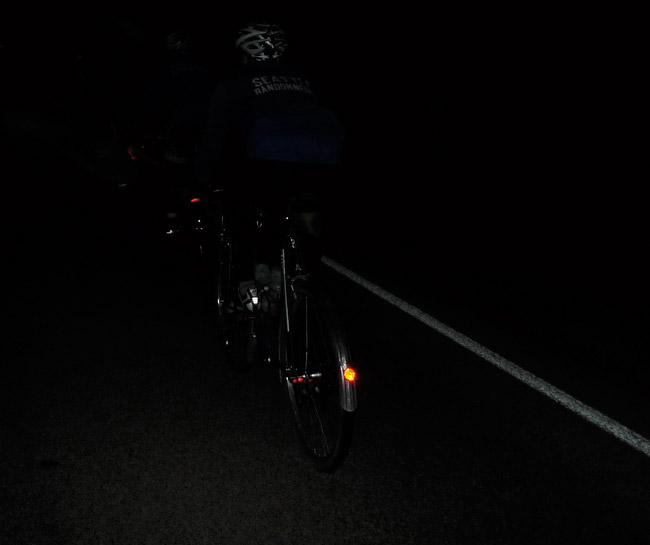When More Visible ≠ Safer: Target Fixation

Looking at the photo above from our Flèche last year, it’s easy to think: “Two of these riders are much safer than the other two.” The reflective vests really stand out in the flash of the camera.
Being hit from behind is one of the primal fears of cyclists. It’s the one accident that we are almost powerless to prevent. We rely on drivers giving us enough room, so it’s important to be visible. It’s perhaps natural to think that if we are even more visible, we somehow can will drivers to give us more room.
In urban environments, the biggest danger for cyclists is being overlooked. There is a lot of visual clutter – even at night – that competes for the attention of drivers. In this scenario, more lights and reflective gear all can be useful to make the rider more visible.
However, the photo above was taken during a moonless night on a backroad miles from the next light. Here, a single red light usually suffices to be seen. Adding a pedal or ankle reflector helps identify the rider as a cyclist. This can be useful for traffic approaching from behind to judge the cyclist’s speed.
Adding even more lights and reflectors may not be a good idea. Most fatalities during U.S. brevets were caused by drivers hitting cyclists who were NOT in their lane of traffic. The victims were on the shoulder or even on the other side of the road, facing the other way. It does not appear that lacking visibility was a concern here – on the contrary, target fixation may have contributed to the accidents.
Target fixation occurs when drivers (or pilots) focus on a light source. As most cyclists know, your bike, car or airplane goes where you look, so if you look at the taillight of a cyclist riding on the shoulder, you are more likely to drift onto the shoulder yourself. This is not a theoretical concern – it has been documented in simulators.
Target fixation appears more pronounced for impaired drivers (whether sleepy or drunk). It also appears to be more pronounced with blinking lights than steady ones. And the brighter the lights, the stronger the target fixation becomes.
Police cars, which are on the shoulder during a traffic stop, are frequently hit by drunk drivers. You would expect drunk drivers to do all they can to avoid police cars, yet they plow right into them. Google “police car hit on shoulder”, and you’ll find many reports of such accidents, and even a video of a car that veers right, glances off a police car, and then hits the car the police has pulled over. Faced with the dangers of target fixation, some police officers now recommend turning off the flashing lights during traffic stops on the shoulder.

What does this mean for cyclists? Really, the safest illumination is one that is powerful enough to show your location, but not so strong that it causes target fixation. When it’s completely dark, even a single red light will be plenty visible.
In fact, when riding on a shoulder at night, it may be safest to be invisible. The odds that a driver will swerve randomly onto the shoulder and hit you may be smaller than the odds of attracting an impaired driver through target fixation.
(However, if you ride without taillights on the shoulder, you are not complying with the law and randonneuring rules, and there is the risk that you will forget to switch on your taillight when you leave the shoulder and ride on the road again.)
When you think about target fixation, you also realize that blinding oncoming traffic with high-powered or even flashing lights appears to be downright suicidal. The same applies to helmet lights – if you are looking at a car coming the other way, you guide them right toward you!
For me, this means that in urban environments, I wear reflective materials. Even there, I don’t see the need to light up my bike like a Christmas tree, because my headlight actually makes me much more visible at night than I am during daytime. On dark rural roads, I will take off my reflective vest. I will rely on my taillight and reflective ankle bands to broadcast my location and speed, without dazzling drivers or having them lock onto me in a bout of target fixation.
How do you stay safe when riding at night?
Further reading:


